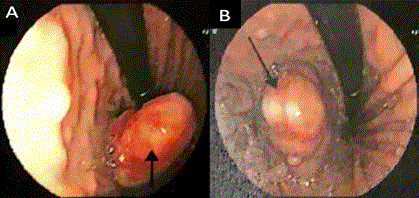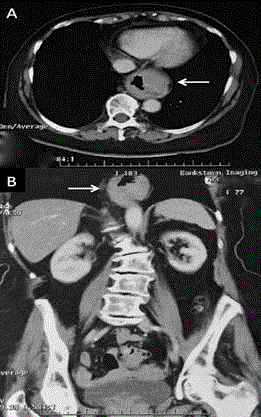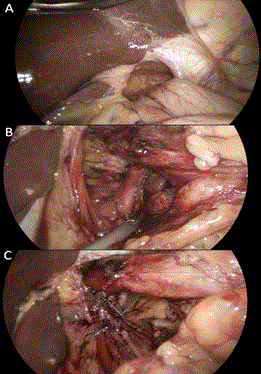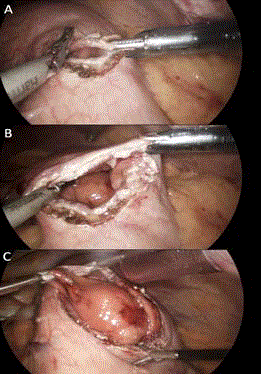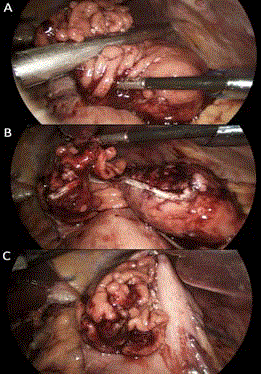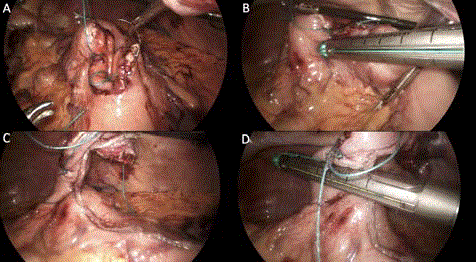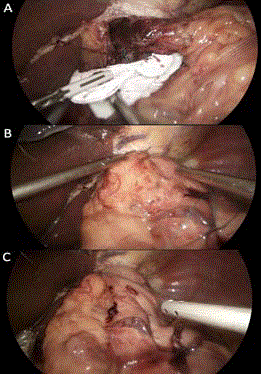Case Report
Laparoscopic Transgastric Resection of Intraluminal Gastric Gist with Concurrent Mesh Repair of Large Sliding Hiatus Hernia: A Case Report
Christophe R. Berney*
Department of Surgery, Bankstown-Lidcombe Hospital, University of New South Wales, Australia
*Corresponding author: Christophe R. Berney, Department of Surgery, Bankstown-Lidcombe Hospital, University of New South Wales, 68 Eldridge Road, Bankstown, NSW 2200, Australia
Published: 12 Oct, 2018
Cite this article as: Berney CR. Laparoscopic Transgastric
Resection of Intraluminal Gastric Gist
with Concurrent Mesh Repair of Large
Sliding Hiatus Hernia: A Case Report.
Clin Surg. 2018; 3: 2156.
Abstract
Gastrointestinal Stromal Tumours (GISTs) are rare and most commonly found in the stomach.
Depending on their size and location, laparoscopy is the preferred technique as the tumour can
be easily removed by simple wedge excision of the gastric wall. However, if the GIST is located in
the posterior gastric wall or near the cardio-Oesophageal Junction (COJ) where complete excision
might be particularly difficult to achieve, such lesion can still be safely managed laparoscopically
through atailored transgastric approach, with excellent long-term results.
We present the case of a 77-year-old female with a large (>5 cm) sliding hiatus hernia diagnosed
with the presence of an associated gastric GIST, located close to the COJ, and that had migrated
into the mediastinum. She underwent successful combined laparoscopic transgastric excision
of the tumour with mesh repair of her hiatus hernia, and anterior partial fundoplication. The
patient was discharged 3 days later on a soft diet and subsequently made a swift recovery with
complete resolution of her pre-operative symptoms. Final histopathology report confirmed the
diagnosis of low malignant potential well-circumscribed gastric GIST and margins were clear (R0).
A surveillance gastroscopy and CT-scan at one-year post surgery were normal. She is at almost
2-yearspostoperative and remains asymptomatic.
In this instance, an adapted surgical approach was necessary to facilitate safe and complete removal
of the gastric GIST, following reduction of her large hiatus hernia. We believe that such proposed
sequential approach can be safely performed with minimum risk, irrespective of the patient’s age.
Introduction
Gastrointestinal stromal tumours (GISTs) are rare and most commonly found in the stomach. Local surgical resection- with histologically verified negative margins (R0), but without routine lymphadenectomy -is the treatment of choice [1]. Depending on its size and location (anterior wall or greater curvature), laparoscopy is the preferred technique as the tumour can be easily removed by simple wedge excision of the gastric wall. This approach promotes significantly reduced morbidity and equivalent long-term oncological outcome when compared to open resection [2,3]. However, if the GIST is located in the posterior gastric wall or near the cardio-oesophageal junction (COJ) where complete excision might be particularly difficult to achieve and may lead to postoperative stricture or leakage, such lesion can still be safely managed laparoscopically through a tailored transgastric approach, with excellent long-term results [4].
Case Presentation
We present the case of a 77-year-old female with past medical history of high blood pressure,
dyslipidaemia and type 2-diabetes, investigated for iron deficiency anaemia along with abdominal
bloating and reflux symptoms. A gastroscopy demonstrated the presence of a large (>5 cm)
sliding hiatus hernia associated with a solid submucosal mass projecting into the lumen from the
fundus of the stomach and located in close proximity (<3 cm) to the COJ that had migrated into
the mediastinum (Figure 1). The rest of the endoscopy was unremarkable. This lesion was entirely
intra-thoracic on CT-imaging, situated in the posterior mediastinum and suggestive of gastric GIST
(Figure 2). There were no associated lymphadenopathies or evidence of distant metastasis. The mass
was irregular and heterogeneous, measuring 5.5 cm × 4.2 cm on endoscopic ultrasound (US). USguided
biopsy confirmed the diagnosis of submucosal gastric GIST (CD117 +++).
The patient was scheduled for an elective combined laparoscopic
transgastric excision of the tumour with mesh repair of herhiatus
hernia and anterior partial fundoplication. Prior to surgery, she was
given Optifast for one week to reduce her liver size and improve
access to the diaphragmatic hiatus. She was positioned in supine
reverse Trendelenburg position with the primary operator standing
between her legs and the first assistant on the patient’s left side. A
pneumoperitoneum maintained at 12 mmHg was initially achieved
via a Verress needle inserted at Palmer’s point. A standard four trocars
technique was employed in the upper abdomen and a Nathanson
liver retractor was inserted under direct vision. First step of this
procedure consisted of a complete mobilisation and reduction of
the hiatus hernia with excision of the hernia sac; “abdominalisation”
of the lower oesophagous along with posterior cruroplasty using
non-absorbable interrupted 1Ethibond Excel Polyester sutures
(Ethicon Endo-Surgery, Cincinnati, OH, USA), as shown in Figure
3. The second step included creation of an anterior gastrotomy
with ultrasonic shears (Harmonic Scalpel, Ethicon Endo-Surgery),
identification and exteriorisation of the gastric GIST through the
gastric opening (Figure 4), complete excision of the lesion using and
articulated size 60 mm endoscopic linear stapler (Echelon FlexTM,
Ethicon Endo-Surgery) taking care not to finish too close to the COJ
with the stapling device (Figure 5), and closure of the gastrotomy after
careful control of intragastric haemostasis using the same endoscopic
linear stapler (Figure 6). The final step involved cruroplasty rein
for cement with placement of a small size CruraSoftTM Patch mesh
(Bard®, Davol Inc., Warwick, RI, USA) fixed with human fibrin glue
(Tisseel, Baxter, Deerfield, IL, USA) and partial 180o anterior Dor
fundoplication using interrupted 2/0 Ethibond sutures (Figure 7).
The resected gastric GIST was placed in a specimen retrieval bag
(Inziii® Retrieval System, Applied Medical, Rancho Santa Margarita,
CA, USA) and safely removed from the abdominal cavity via a
transverse left upper quadrant incision using an Alexis® O Wound
Protector (Applied Medical). A small drain was left next to the
anastomosis for 2 days and a nasogastric tube maintained overnight.
Clear fluids were allowed on the first postoperative day and the
patient was discharged 3 days later on a soft diet. Final histopathology
report confirmed the diagnosis of low malignant potential wellcircumscribed
gastric GIST with no mitosis, vascular or perineural
invasion, and margins were clear (R0). The patient subsequently
made a swift recovery with complete resolution of her pre-operative
symptoms. A surveillance gastroscopy and CT-scan at one-year post
surgery were normal. She is at almost 2-years postoperative and
remains asymptomatic.
Figure 1
Figure 2
Figure 2
A) Axial chest view of gastric lesion (arrow) within sliding hiatus
hernia; B) Coronal view same intra-gastric mass (arrow) located in posterior
mediastinum.
Figure 3
Figure 3
A) Hiatus hernia defect exposed; B) Complete mobilisation distal
oesophagous (hernia sac already excised); C) Posterior cruroplasty with
interrupted 1 Ethibond sutures (at least 3 cm of the distaloesophagous is
intra-abdominal).
Figure 4
Figure 4
A+B) Anterior gastrostomy with ultrasonic shears; C) Mobilisation
and “eversion” endophytic gastric GIST.
Figure 5
Figure 5
Tumour elevation and stapler placement; B) Control haemostasis
staple line; C) “inversion” spared normal gastric mucosa.
Figure 6
Figure 6
A) Reapproximationgastrotomy edges with stay sutures; B+C+D)
Closure gastrotomy with linear stapler.
Discussion
In 1996, Geis et al [5,6] were the first to describe the technique of
laparoscopic transgastricresection of gastric GIST, followed up one
month later by Watson and coll. This approach is particularly useful
for endophytic lesions situated in the posterior gastric wall or near
the COJ, where a simple wedge excisionis unfeasible and endoscopic
resection is not an option due to their size and/or location. Since
then, several variations of this technique have been described and
well summarized in a recent article [7]. In our case, the tumour was
relatively large and arising from the proximal gastric fundus that had
migrated into the chest, making its excision quite challenging gas it
could easily lead to an excessive amount of normal gastric wall being
incorporated into the resection, thus risking involving the COJ in the
process, or even worse, ending up with a microscopically inadequate
tumour clearance. To minimize those risks, we were able to use an
“eversion” technique where the GIST was safely exteriorised through
the gastric opening and divided under direct vision, preserving
as much normal gastric tissue as possible with total control of the
tumour edges, whilst maintaining adequate distance between the
staple line of the endo-GIA and the COJ [8].
The associated large sliding hiatus hernia added significant
difficulty to this case as both pathologies required simultaneous repair.
This procedure was therefore divided into three chronological steps:
The first “hiatus hernia reduction” step was important to subsequently
allow safe access into the stomach via an anterior gastrotomy. Once
the gastric GIST was completely excised and the gastrotomy closed,
mesh reinforcement of the cruroplasty with anterior fundoplication
offered extra protection to the tumour excision bed as the fundus
positioned over the top of the oesophagous is secured superiorly to
the diaphragm, therefore theoretically minimizing the potential risk
of leak at this level.
Anterior 180° D or fundoplication is the author’s preferred antireflux
operation as it generally offers better overall outcome to the
patients when compared to Nissen technique [9]. It also seems to
provide a stronger repair, as a significant part of the gastric wall is
utilized to reinforce the diaphragmatic hiatus. The prosthetic used
in this case was a PTFE/ePTFE dual-side mesh. Recently, the author
has changed to a new synthetic and totally bioabsorbable scaffolding
made of polyglycolide and teimethylene carbonate (Gore BioA Tissue
ReinforcementTM, Flagstaff, AZ) to reinforce the crural closure, as it
may potentially decrease the risk of erosion through the oesophagous
[10]. The choice of routinely securing the mesh with non-traumatic
fibrin glue in large hiatus hernia was mainly for safety, but also driven
by the fact that there is a small but well recognized risk of inflicting
iatrogenic life-threatening cardiac tamponade from tacker or even
suture usage [11].
A very similar case of a 68-year-old female with a 3.5 cm × 2 cm
GIST located 2cm from the COJ and associated with a hiatus hernia
was previously described [12]. The tumour resection was completed
using a combined laparo-endoscopic approach with endoscopic
removal of the lesion. In our case, the lesion was significantly larger
and transgastric retrieval was therefore the only option available.
To our knowledge, this is the first case report of an elderly patient
undergoing concurrent laparoscopic transgastric GIST excision with
mesh repair of a large sliding hiatus hernia. The main advantage
of such an approach over laparotomy is multifactorial, and mainly
consists in reduced overall morbidity and faster recovery, with very
low risk of developing delayed incisional hernia. This is particularly
the case when the main opening for specimen retrieval is off-midline
in a transverse blunt muscle-splitting incision [13].
In this instance, an adapted surgical approach was necessary to
facilitate safe and complete removal of the gastric GIST, following
reduction of the hiatus hernia, with limited resection of normal
gastric mucosa. As already mentioned by others, “there is no goldstandard
method for tailored resection, and the surgical technique
is chosen at the discretion of the surgeon” [7]. We believe that such
proposed sequential approach for combine treatment of large sliding
hiatus hernia with intragastric GIST, can be safely performed with
minimum risk, irrespective of the patient’s age.
Figure 7
Figure 7
A) Cruroplasty reinforced with CruraSoftTM Patch mesh; B) Partial
anterior D or fundoplication; C) Final view repair.
References
- DeMatteo RP, Lewis JJ, Leung D, Mudan SS, Woodruff JM, Brennan MF. Two hundred gastrointestinal stromal tumors: recurrence patterns and prognostic factors for survival. Ann Surg. 2000;231:51-8.
- Chen QL, Pan Y, Cai JQ, Wu D, Chen K, Mou YP. Laparoscopic versus open resection for gastric gastrointestinal stromal tumors: an updated systematic review and meta-analysis. World J Surg Oncol 2014;12:206.
- Koh YX, Chok AY, Zheng HL, Tan CS, Chow PK, Wong WK, et al. A systematic review and meta-analysis comparing laparoscopic versus open gastric resections for gastrointestinal stromal tumors of the stomach. Ann Surg Oncol. 2013;20(11):3549-60.
- Siow SL, Mahendran HA, Wong CM. Laparoscopic transgastric resection for intraluminal gastric gastrointestinal stromal tumors located at the posterior wall and near the gastroesophageal junction. Asian J Surg. 2017;40(5):407-14.
- Geis WP, Baxt R, Kim HC. Benign gastric tumors. Minimally invasive approach. Surg Endosc. 1996;10(4):407-10.
- Watson DI, Game PA, Devitt PG. Laparoscopic resection of benign tumors of the posterior gastric wall. Surg Endosc. 1996;10(5):540-1.
- Choi CI, Lee SH, Hwang SH, Kim DH, Jeon TY, Kim DH, et al. Various features of laparoscopic tailored resection for gastric submucosal tumors: a single institution’s results for 168 patients. Surg Endosc. 2016;30(4):1450-8.
- Hyung WJ, Lim JS, Cheong JH, Kim J, Choi SH, Noh SH. Laparoscopic resection of a huge intraluminal gastric submucosal tumor located in the anterior wall: eversion method. J Surg Oncol. 2005;89(2):95-8.
- Broeders JA, Roks DJ, Ahmed Ali U, Watson DI, Baigrie RJ, Cao Z, et al. Laparoscopic anterior 180-degree versus nissen fundoplication for gastroesophageal reflux disease: systematic review and meta-analysis of randomized clinical trials. Ann Surg. 2013;257(5):850-9.
- Powell BS, Wandrey D, Voeller GR. A technique for placement of a bioabsorbable prosthesis with fibrin glue fixation for reinforcement of the crural closure during hiatal hernia repair. Hernia. 2013;17(1):81-4.
- Köckerling F, Schug-Pass C, Bittner R. A word of caution: never use tacks for mesh fixation to the diaphragm! Surg Endosc. 2018;32(7):3295-302.
- Vinnicombe Z, Little M, Wan A. Laparo-endoscopic combined approach for excision of gastrointestinal stromal tumour close to the oesophagogastric junction. J Surg Case Rep. 2015;7:1-3.
- Berney CR. A consideration for the linea alba in the laparoscopic colorectal era. Dis Colon Rectum. 2014;57(5):675-6.

